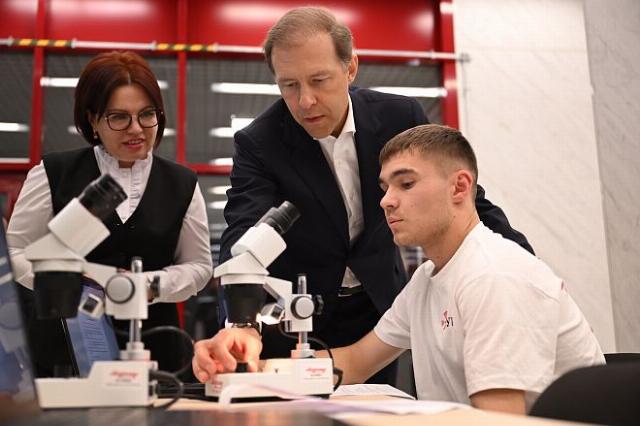The First Deputy Prime Minister of Russia appreciated the modernization of the Kazan Aircraft Factory and the Kazan Helicopter Plant, and also got acquainted with the work on the Tu-214 airliner and the import-substituted Ansat
First Deputy Prime Minister of Russia Denis Manturov visited aircraft manufacturing enterprises of Rostec State Corporation in Kazan as part of a working visit. He got acquainted with the implementation of the Tu-214 civil airliner program and the expansion of production capacities of the S.P. Gorbunov Kazan Aviation Plant (part of the United Aircraft Corporation). The Deputy head of government also visited the Kazan Helicopter Plant (part of the Russian Helicopters holding company), where he assessed the progress of work on the import-substituted Ansat helicopter and inspected the latest modification of the Mi-171A3 in the AURUS configuration.
The Deputy Prime Minister's visit took place on the eve of the BRICS leaders' summit, which will be held in Kazan from October 22 to 24. Aircraft and helicopters manufactured by Rostec enterprises will also be shown to the guests of the event within the framework of the Made in Tatarstan exhibition. In particular, the Mi-171A3 helicopters in the AURUS configuration, the upgraded Ansat with a sanitary module, the Mi-38 in a business configuration and the Tu-214 civil airliner will be on display.
The first deputy head of the UAC is the Managing Director of Tupolev JSC (part of Rostec) Konstantin Timofeev reported to Denis Manturov on the modernization of the Kazan Aircraft Factory and the prospects for increasing the production of the Tu-214 aircraft. Large-scale works on the construction and reconstruction of the enterprise are planned to be completed by the end of 2026. Currently, the process of constructing new and modernizing existing production buildings, flight test facilities and a number of other facilities is underway.
"Of the 24 planned facilities, nine have already been commissioned, 15 facilities are in varying degrees of readiness. With the commissioning of all planned facilities, the company will significantly reduce the production time. The new facilities and equipment will allow us to enter mass production of civilian vessels and ensure the construction of 20 Tu-214 aircraft per year," Konstantin Timofeev said.
The First Deputy Prime Minister also inspected the high-tech equipment recently launched at the Kazan Aircraft Factory for the manufacture of large-sized parts. The novelty was developed and manufactured by specialists of the STAN holding of Rostec State Corporation. The Russian portal five-axis milling machining center with a vacuum table will allow manufacturing components made of aluminum alloys, including wing parts with a maximum size of up to 24 meters. At the same time, the execution time of individual stages of the production cycle will be significantly reduced. In 2025, another similar machine is planned to be put into operation at the aircraft factory.
During his visit to the aircraft factory, Denis Manturov inspected one of the Tu-214 aircraft under construction. The car is planned to be delivered to the customer by the end of this year. He was also shown a flying laboratory where spare parts and components of domestic production are tested as part of the full import substitution program. By the end of the year, it is planned to test fire alarms, air conditioning, automatic control and other systems at the flying laboratory.
In addition, the Deputy Prime Minister, together with Nikolai Yakovlev, General Director of the Kazan Helicopter Plant, inspected the main production facilities of the enterprise. Helicopters of the Mi-8/17 family, multi-purpose Mi-38 and light Ansat helicopters are produced at this site.
The Deputy head of government got acquainted with the progress of the large modernization of the helicopter building enterprise. He inspected the mechanical assembly building under construction, visited the new building of the final assembly workshop and the hangar of the flight test complex. There Denis Manturov was shown the Mi-8MTV-1 helicopters and the latest multi-purpose Mi-38, and also reported on the status of the program for the import-substituted Ansat. At the moment, all foreign components of the control system and autopilot have been replaced with domestic ones on the helicopter, and Russian VK-650V engines manufactured by the United Engine Corporation (part of Rostec) have been installed. Preparations are currently underway for ground checks of the aircraft, which will be followed by flight tests of the Ansat with new engines. The first flight is scheduled to take place before the end of this year.
In addition, a helicopter modernization program is being implemented in parallel — increasing its take-off weight and installing an anti-icing system. The flight range will also increase to 640 km (up to 800 km with an additional fuel tank).
The Deputy Prime Minister inspected the Mi-171A3 in the latest AURUS modification, created specifically for business transportation. In this version, the helicopter can carry up to ten passengers, its cabin includes everything necessary for a comfortable long-distance flight. This helicopter is a good example of expanding inter—factory cooperation. The cargo floor and propeller blades are manufactured at the Kazan Helicopter Plant. The Far Eastern enterprise AAK Progress manufactures composite elements — the cockpit and side panels of the fuselage, the production of other elements and final assembly is carried out at the Ulan-Ude Aviation Plant.
Denis Manturov was also shown the latest Production and Training Center (PTC). This unique industrial and educational complex will allow training up to 3,500 highly qualified multi-specialists per year. Classes have already begun here for students and employees of the plant, who receive several sought-after professions at the same time. Educational programs have been developed for the center in eight areas and 38 professions. The emphasis in training is on practice, which takes up to 70% of the training time. For this purpose, the PUC has 15 production sites, 12 laboratories and 21 classrooms.

